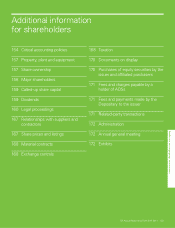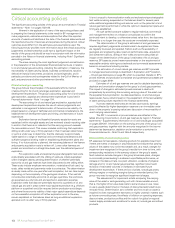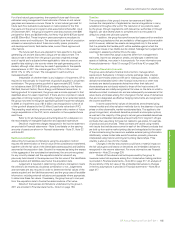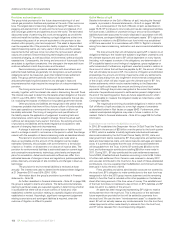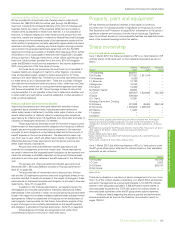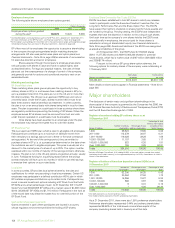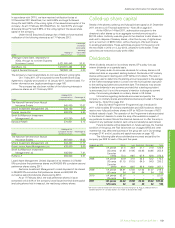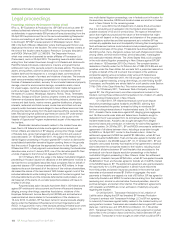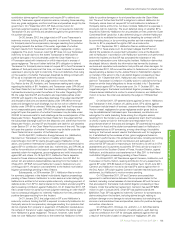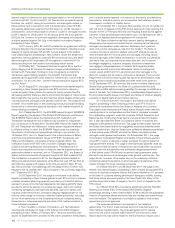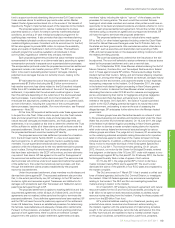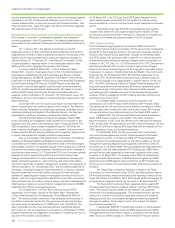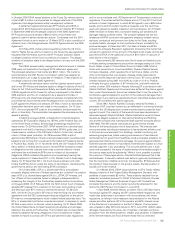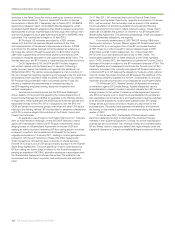BP 2011 Annual Report Download - page 165
Download and view the complete annual report
Please find page 165 of the 2011 BP annual report below. You can navigate through the pages in the report by either clicking on the pages listed below, or by using the keyword search tool below to find specific information within the annual report.
Additional information for shareholders
BP Annual Report and Form 20-F 2011 163
Additional information for shareholders
fund to support continued advertising that promotes Gulf Coast tourism.
It also resolves claims for additional payments under certain Master
Vessel Charter Agreements entered into in the course of the Vessels of
Opportunity Program implemented as part of the response to the Incident.
The proposed agreement to resolve medical claims involves
payments based on a matrix for certain currently manifested physical
conditions, as well as a 21-year medical consultation programme for
qualifying class members. It also provides that class members claiming
later-manifested physical conditions may pursue their claims through a
mediation/litigation process. Consistent with its commitment to the Gulf,
BP has also agreed to provide $105 million to improve the availability,
scope and quality of healthcare in Gulf communities. This healthcare
outreach programme would be available to all individuals in those
communities, regardless of whether they are class members.
Each proposed agreement provides that class members would be
compensated for their claims on a claims-made basis, according to agreed
compensation protocols in separate court-supervised claims processes.
The compensation protocols under the proposed economic loss settlement
agreement include a risk transfer premium (RTP). The RTP is an agreed
factor to be used in calculating certain types of damages, including
potential future damages that are not currently known, relating to the
Incident.
BP estimates the cost of the proposed settlement would be
approximately $7.8 billion (including the $2.3 billion commitment to
help resolve economic loss claims related to the Gulf seafood industry).
While this is BP’s reliable best estimate of the cost of the proposed
settlement, it is possible that the actual cost could be higher or lower
than this estimate depending on the outcomes of the court-supervised
claims processes. In accordance with its normal procedures, BP will
re-evaluate the assumptions underlying this estimate on a quarterly basis
as more information, including the outcomes of the court-supervised
claims processes, becomes available. (For more information, see Financial
statements – Note 36.)
At this time, BP expects all settlements under these agreements
to be paid from the Trust. Other costs to be paid from the Trust include
state and local government claims, state and local response costs,
natural resource damages and related claims, and final judgments and
settlements. It is not possible at this time to determine whether the Trust
will be sufficient to satisfy all of these claims as well as those under the
proposed settlement. Should the Trust not be sufficient, payments under
the proposed settlement would be made by BP directly.
The proposed economic loss settlement provides for a transition
from the Gulf Coast Claims Facility (GCCF) to a new court-supervised
claims programme, to administer payments made to qualifying class
members. A court-supervised transitional claims process will be in
operation while the infrastructure for the new settlement claims process
is put in place. During this transitional period, the processing of claims
that have been submitted to the GCCF will continue, and new claimants
may submit their claims. BP has agreed not to wait for final approval of
the economic loss settlement before claims are paid. The economic loss
claims process will continue under court supervision before final approval
of the settlement, first under the transitional claims process, and then
through the settlement claims process established by the proposed
economic loss settlement.
Under the proposed settlement, class members would release and
dismiss their claims against BP. The proposed settlement also provides
that, to the extent permitted by law, BP will assign to the PSC certain of
its claims, rights and recoveries against Transocean and Halliburton for
damages with protections such that Transocean and Halliburton cannot
pass those damages through to BP.
The proposed settlement is subject to reaching definitive and fully-
documented agreements within 45 days of 2 March 2012, and if those
agreements are not reached, either party has the right to terminate the
proposed settlement. Once definitive agreements have been reached, BP
and the PSC will seek the court’s preliminary approval of the settlement.
Under US federal law, there is an established procedure for determining
the fairness, reasonableness and adequacy of class action settlements.
Pursuant to this procedure, and subject to the court granting preliminary
approval of both agreements, there would be an extensive outreach
programme to the public to explain settlement agreements and class
members’ rights, including the right to “opt out” of the classes, and the
processes for making claims. The court would then conduct fairness
hearings at which class members and various other parties would have an
opportunity to be heard and present evidence and decide whether or not to
approve each proposed settlement agreement. Should the number of class
members opting out exceed an agreed and court-approved threshold, BP
will have the right to terminate the proposed settlement.
The proposed settlement does not include claims made against
BP by the DoJ or other federal agencies (including under the Clean Water
Act and for Natural Resource Damages under the Oil Pollution Act) or by
the states and local governments. Also excluded are certain other claims
against BP, such as securities and shareholder claims pending in MDL
2185, and claims based solely on the deepwater drilling moratorium and/or
the related permitting process.
The court has subsequently ordered that the first phase of the trial
be adjourned. The court will schedule a status conference to discuss issues
raised by the proposed settlement and to set a new trial date.
On 15 September 2010, three Mexican states bordering the Gulf of
Mexico (Veracruz, Quintana Roo, and Tamaulipas) filed lawsuits in federal
court in Texas against several BP entities. These lawsuits allege that the
Incident harmed their tourism, fishing, and commercial shipping industries
(resulting in, among other things, diminished tax revenue), damaged natural
resources and the environment, and caused the states to incur expenses
in preparing a response to the Incident. On 9 December 2011, the judge
in the federal multi-district litigation proceeding in New Orleans granted
in part BP’s motion to dismiss the three Mexican states’ complaints,
dismissing their claims under OPA 90 and for nuisance and negligence
per se, and preserving their claims for negligence and gross negligence
only to the extent there has been a physical injury to a proprietary
interest of the states. On 5 April 2011, the State of Yucatan submitted
a claim to the GCCF alleging potential damage to its natural resources
and environment, and seeking to recover the cost of assessing the
alleged damage. BP anticipates further claims from the Mexican federal
government.
Citizens groups have also filed either lawsuits or notices of intent
to file lawsuits seeking civil penalties and injunctive relief under the Clean
Water Act and other environmental statutes. On 16 June 2011, the judge
in the federal multi-district litigation proceeding in New Orleans granted
BP’s motion to dismiss a master complaint raising claims for injunctive
relief under various federal environmental statutes brought by various
citizens groups and others. The judge did not, however, lift an earlier stay
on the underlying individual complaints raising those claims for injunctive
relief or otherwise apply his dismissal of the master complaint to those
individual complaints. In addition, a different set of environmental groups
filed a motion to reconsider dismissal of their Endangered Species Act
claims on 14 July 2011. That motion remains pending. On 31 January
2012, the court, on motion by the Center for Biological Diversity, entered
final judgment on the basis of the 16 June 2011 order with respect to two
actions brought against BP by that plaintiff. On 2 February 2012, the Center
for Biological Diversity filed a notice of appeal of both actions.
On 15 July 2011, the judge granted BP’s motion to dismiss a
master complaint raising RICO claims against BP. The court’s order
dismissed the claims of the plaintiffs in four RICO cases encompassed by
the master complaint.
The DoJ announced on 7 March 2011 that it created a unified task
force of federal agencies, led by the DoJ Criminal Division, to investigate
the Incident. Other US federal agencies may commence investigations
relating to the Incident. The SEC and DoJ are investigating securities
matters arising in relation to the Incident.
On 21 April 2011, BP entered a framework agreement with natural
resource trustees for the US and five Gulf coast states, providing for up
to $1 billion to be spent on early restoration projects to address natural
resource injuries resulting from the Incident. Funding for these projects will
come from the $20-billion Trust fund.
BP’s potential liabilities resulting from threatened, pending and
potential future claims, lawsuits and enforcement actions relating to
the Incident, together with the potential cost of implementing remedies
sought in the various proceedings, cannot be fully estimated at this time
but they have had and are expected to have a material adverse impact
on the group’s business, competitive position, cash flows, prospects,


